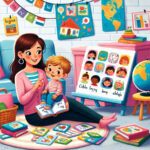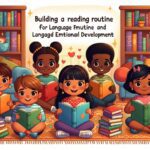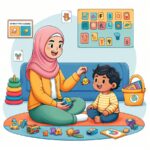Supporting bilingual development in infancy is not just about teaching a baby two languages; it’s about opening a window to a world of cognitive, social, and cultural opportunities. Recent studies underscore the benefits of raising bilingual children, from enhanced problem-solving skills to greater empathy towards others. This article explores the importance of nurturing bilingualism from infancy and provides practical strategies for parents and caregivers.
Understanding the Foundations of Bilingual Development
Bilingual development in infancy begins with exposure. Babies are born with the ability to distinguish between all phonetic sounds, regardless of language. Over time, they start to specialize in the sounds of the languages they’re exposed to regularly. This critical period is when the foundation for language learning is most malleable. Creating an environment where the infant is consistently exposed to two languages can optimize their ability to become fluent bilingual speakers. The American Speech-Language-Hearing Association highlights the cognitive advantages of bilingualism, making an early start even more beneficial.
However, supporting bilingual development in infancy isn’t just about passive exposure. Interaction is key. Engaging with your baby in both languages through everyday activities—like reading, singing, and simple conversation—helps reinforce their language skills. This approach ensures that language learning is not only effective but also a bonding experience between you and your child.
Strategies for Supporting Bilingual Development in Infancy
To foster a bilingual environment for your infant, consider the following strategies. First, be consistent. Choose a strategy for language exposure, such as ‘one person, one language’ where each caregiver speaks a different language to the baby, or ‘one place, one language,’ where the language spoken is determined by the location, such as home versus daycare. Consistency helps babies learn to distinguish between languages more easily.
Second, incorporate both languages naturally into daily routines. Utilize books, music, and toys in both languages. For example, reading bedtime stories in both languages can be an effective way of supporting bilingual development in infancy, while also establishing a bedtime routine. Similarly, playing music in both languages can enrich a child’s linguistic environment.
Challenges and Solutions in Supporting Bilingual Development
While the benefits of bilingualism are manifold, challenges can arise. One common concern is the potential for delayed speech development. However, research indicates that bilingual children might start speaking slightly later but soon catch up to their monolingual peers without detrimental effects. Patience and understanding are crucial during this period.
Another challenge is maintaining balance between the languages. Often, one language may become dominant due to more exposure. To mitigate this, seek out community resources, such as bilingual playgroups or caregivers, that can provide additional language exposure. Encouraging playful learning through activities like visual tracking activities can also be beneficial in supporting bilingual development.
In conclusion, supporting bilingual development in infancy lays the groundwork for a lifetime of benefits, from cognitive advantages to cultural empathy. By understanding the basics of language development, employing consistent and interactive exposure strategies, and navigating potential challenges with patience, parents and caregivers can effectively support their infant’s journey to bilingualism. Remember, the goal is not just to teach a child two languages but to open their minds to a richer, more diverse world.
For more insights on infant development, explore topics such as soothing techniques for better sleep and creating serene sleep environments, among others, at BabyWhysAndHows.com.













